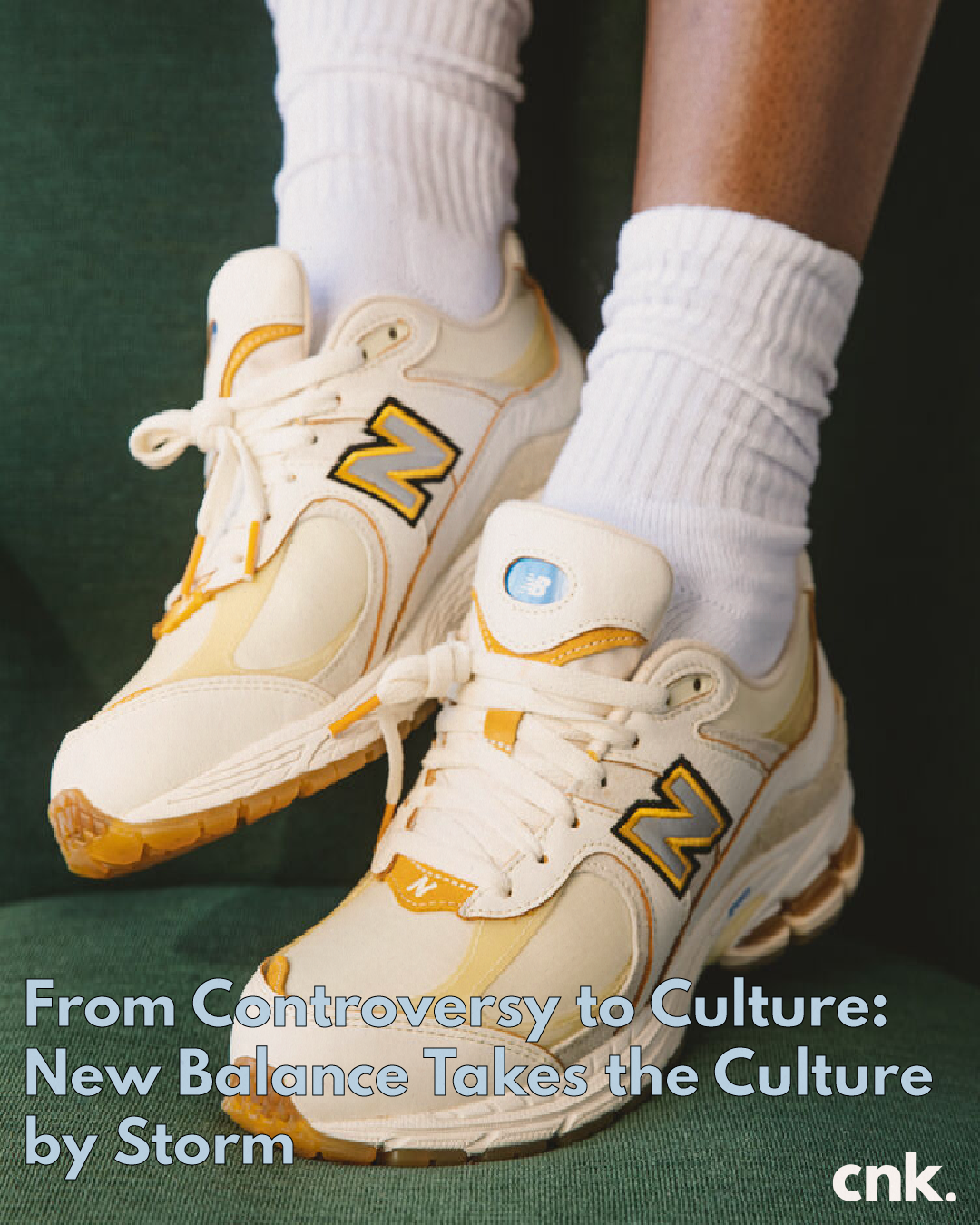From Controversy to Culture: New Balance Takes the Culture by Storm
“I’m not an athlete. I’m not a rapper. I didn’t grow up wearing New Balances,” says Joe Robinson, better known as Chicago-bred streetwear designer Joe Freshgoods, in an interview with HighSnobiety. “So, to be working with New Balance, a very prestigious brand, and what they present in the culture… this whole relationship was super natural.”
Reading this interview with HighSnobiety and Joe Freshgoods as he spoke on his ongoing partnership with New Balance not only inspired me, but it took me down a rabbit hole of finding more campaigns and stories that New Balance has released recently. Now, I’ll be honest, I was not a New Balance fan. I’ve always thought of them as “Dad shoes”–made for older, white men who needed something more comforting and didn't care about style. So, I never paid too much attention to what the brand had going on. However, with the high success of Joe’s releases, the “Conversations Amongst Us” campaign, and seeing more celebrities become brand ambassadors, New Balance definitely has my attention now. But when did this shift happen? How did New Balance quietly become a part of the culture?
Let’s Take it Back to the Old School
To answer this question, we need to start with a little bit of a history lesson on the beginnings of New Balance. It all started in 1906 in Boston, Massachusetts. William J. Riley founded the New Balance Arch Support Company which specialized in arch support and orthopedic footwear. He hired a man named Arthur Hill, who soon after became a partner of the company, and began focusing on selling their products to people who spent a lot of time on their feet like firefighters and retail workers. In 1938, New Balance created their first running shoe for a local running club called the Boston Brown Bag Harriers. They continue to expand their products designed for sports such as tennis, boxing, and baseball.
In 1976, the ‘320’ launched and became the first shoe to feature the famous ‘N’ logo we now see. This began the new tradition of using unique model numbers rather than names for their shoes. The number defines the type of shoe, the activity they intended it for, and whether it was built for stability, speed, and performance. So for example: if the shoe ends in 50, it’s a fitness shoe designed for training on roads or for indoor workouts. If it ends in 70, it has light stability with a sleek profile and is designed for runners who train at a faster pace. In 1992, one of New Balance's most important releases debuted—the ‘990’. The shoe was the first ever sneaker to be retailed at $100 and quickly became a hot commodity in the streets of I-95 in Baltimore, Philadelphia, and Washington, DC. The 990 sneaker was deemed “The Hustler Sneaker.”
“Street guys started to buy the 990 ‘cause it was $100. Because of the price point, street guys wanted to wear something more different than everyone else. That caught the eye of little guys such as myself, impressionable kids.”
The Controversy
New Balance was a household name and prized possession until it all hit the fan in 2016. New Balance was put under fire in the media after a white supremacist blogger and internet troll proclaimed that the New Balance shoes were “the official shoes of White people”. This conversation began after Matt LeBretton, New Balance’s VP of Public Affairs, told the Wall Street Journal that “The Obama administration turned a deaf ear to us and, frankly, with President-elect Trump, we feel things are going to move in the right direction”, after being asked to comment about the US trade policy and the Trans-Pacific Partnership. So, with every controversial situation that comes out in the media with a brand, loyal customers immediately begin to express their disgust on social media and with action. Videos of people burning their New Balance shoes began to go viral and the customers were letting everyone know that they were switching to another shoe brand. New Balance released a statement on Twitter saying that LeBretton’s statement was taken out of context, but it seemed the damage was already done because it was then turned into “New Balance is pro-Trump”.
While the shoe giant’s PR team tried to remove itself from the white supremacy conversation, a few months later, more news was released that the New Balance Owner and Chairman, Jim Davis, quietly donated almost $400,000 to Trump Victory, a joint fundraising group for the Trump campaign and the Republican National Committee. The company released another statement saying, “New Balance did not endorse a candidate in this presidential election or any other. An employee’s personal support of a candidate does not equate to a company endorsement.” The conversation continued to sway between customers continuing to disown the shoe and Trump supporters being loud and proud about buying their first New Balance shoes in what they believed was support. The controversy did eventually fade, but the shoe giant definitely took it personally. The rebrand shift quietly began with the beginning of its new collaboration phase, as well as starting a new minority-led employee collective that would lead New Balance into the promised land of Black culture.
From Controversy to Culture
Streetwear brands KITH, Bodega, and Concepts have been longtime partners of New Balance for over a decade, and have consistently rotated the ‘997’, ‘998’, and ‘574’ silhouettes. But it didn’t really bring in its new generation of buyers. However, when New York-based sportswear brand, Aime Leon Dore, took on the ‘827’ silhouette with their collaboration, it sparked a new direction in New Balance’s marketing strategy. It introduced the art of storytelling. Going forward, they began to hone in on each of their collaborator’s unique perspectives, their own fanbase, and narrative and let them use the shoe to bring their stories to life.
Since the marketing strategy started to shift, the shoe giant had to shift internally as well. They embarked on another mission to overhaul its operations by including tapping more diverse designers and hiring more minority employees. In 2019, they created a new internal collective for Black employees called the Black Soles. The New Balance Black Soles group has been very intentional in creating projects that invoke meaningful dialogue as well as celebrating Black culture. It seemed like they took the phrase, “If You Know, You Know”, in their hands and turned it into a lifestyle.
“We always pictured the program to have this level of impact. Telling authentic black stories has been the intention each year. From inspiring the community to chase their dreams, to reminding the community that our story matters. This year we wanted to continue that narrative and emphasize the benefit of group gatherings on the Black community.”
We see brands try to add our culture into their marketing campaigns all of the time, but the feeling I got when watching the “Conversations Amongst Us” campaign video with Joe Freshgoods featuring NBA star and New Balance Brand Ambassador, Kawhi Leonard, was something I don’t think I had ever felt before. They didn’t speak at all, but their facial expressions said a thousand words. Even though the subtitles throughout the video let the world in on what they were actually saying, any Black person who grew up in a Black household, in a Black community, had already seen those expressions before and immediately knew what they meant. Even down to Kawhi breaking the fourth wall by smirking at the camera when a white female representative pronounced his name wrong. The campaign continued with another marketing video displaying how the restroom can act as a sanctuary for Black Women. From beauty conversations to drunk nights and vulnerable moments with a friend, this is a place where women remind each other that they are that girl. The feeling of this campaign was special and it didn’t feel like New Balance was trying to force the feeling at all.
The Controversy Needed to Happen for them to Reach New Levels
To me, this is where the shoe giant takes their redemption lap. New Balance understood that they had to stand on what they meant in their statements back in 2016 and 2017, and completely change everyone’s perspective of them by asking the right people for help. Now, New Balance resurgence has skyrocketed and are having release dates just as successful as Nike and Jordan brand. Not all brands have made it out of that dark place of being in a negative light and under fire in the public. Some even stay there and decide not to do or say anything to change the behavior. I admire the initiative and changes that New Balance has made within their company and what they are doing to celebrate our Black culture.


